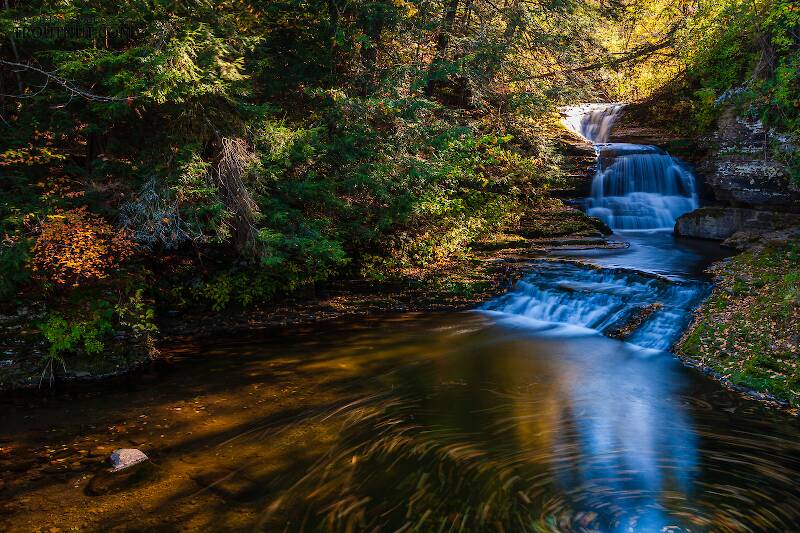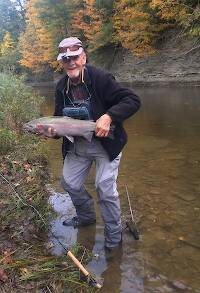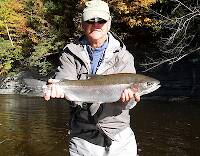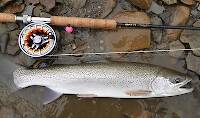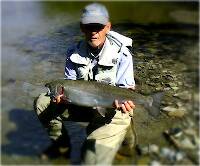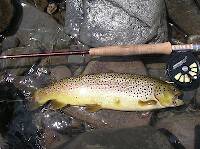
Blue-winged Olives
Baetis
Tiny Baetis mayflies are perhaps the most commonly encountered and imitated by anglers on all American trout streams due to their great abundance, widespread distribution, and trout-friendly emergence habits.
Featured on the forum

I caught this tiny larva without a case, but it seems to key pretty clearly to to Glossosomatidae. From there, the lack of sclerites on the mesonotum points to either Glossosoma or Anagapetus. Although it's difficult to see in a 2D image from the microscope, it's pretty clear in the live 3D view that the pronotum is only excised about 1/3 of its length to accommodate the forecoxa, not 2/3, which points to Glossosoma at Couplet 5 of the Key to Genera of Glossosomatidae Larvae.

Troutnut is a project started in 2003 by salmonid ecologist Jason "Troutnut" Neuswanger to help anglers and
fly tyers unabashedly embrace the entomological side of the sport. Learn more about Troutnut or
support the project for an enhanced experience here.
Sayfu
Posts: 560
Posts: 560
Sayfu on Dec 5, 2011December 5th, 2011, 5:59 am EST
Anyone give any credence to the stage between a nymphs instars before a new exoskeleton forms? Quite some years ago now, maybe it was Borger who suggested that nymphs tied to represent this time frame was a very worthwhile endeavor because the nymph is soft, and desirable to trout during this stage.
Goose
Posts: 77
Posts: 77
Goose on Dec 5, 2011December 5th, 2011, 6:18 am EST
I've been fly tying and fishing for about 25 years and I've never seen one. I'm sure if it was such a great idea we'd all know about it by now. I turn rocks over every time I go fishing and I haven't run into any either there or in the drift. But I'm no bug expert. Maybe there's something I've missed.
Bruce
Bruce
Falsifly on Dec 5, 2011December 5th, 2011, 7:52 am EST
Although it’s difficult to read a trout’s mind I would think that trout find nymphs desirable regardless of stage. But maybe I’m mistaken; I suppose they could be thinking: Boy with all these yummy nymphs available I can be picky. I think today I will dine on my favorites, the soft ones.
Falsifly
When asked what I just caught that monster on I showed him. He put on his magnifiers and said, "I can't believe they can see that."
When asked what I just caught that monster on I showed him. He put on his magnifiers and said, "I can't believe they can see that."
Sayfu
Posts: 560
Posts: 560
Sayfu on Dec 5, 2011December 5th, 2011, 9:46 am EST
Don't think it is necessarily a trout being picky. They could just easily key on those types nymphs in skeletal transition, and the angler, for one, would be fishing a stage, and fly design few others fish. I know of no one that fishes a nymph in this stage, and am always interested in fishing a fly others haven't fished.
PaulRoberts on Dec 5, 2011December 5th, 2011, 10:37 am EST
I've collected and photo'd them. I also remember someone espousing white nymphs for fishing, but don't remember who. Google "white nymphs" and I bet you find a reference.
I've tied and done well on white nymphs. In particular I fish a nearly white golden stone pattern I call a "shedding stonefly". I posted a pic of one a while back -in a thread Tony started about a particular stonefly.
As Falsifly says, I doubt many fish would pass on ANY nymph. At least in most streams where trout cannot afford to be too choosy. And, if the insects are anything like crayfish, they'd be hunkered down and well concealed when molting.
I've done particularly well on this fly when creeks are roiled following rains. It's a go-to then and I think it's particularly visible in those conditions, and that may be all there is to it. Why not...chartreuse? Aesthetics I guess. I like to THINK I'm matching something in nature, when again, visibility may be all there is to it. But, I'll pitch chartreuse to any lake-run fish without qualm. Weird animals we are.
I've tied and done well on white nymphs. In particular I fish a nearly white golden stone pattern I call a "shedding stonefly". I posted a pic of one a while back -in a thread Tony started about a particular stonefly.
As Falsifly says, I doubt many fish would pass on ANY nymph. At least in most streams where trout cannot afford to be too choosy. And, if the insects are anything like crayfish, they'd be hunkered down and well concealed when molting.
I've done particularly well on this fly when creeks are roiled following rains. It's a go-to then and I think it's particularly visible in those conditions, and that may be all there is to it. Why not...chartreuse? Aesthetics I guess. I like to THINK I'm matching something in nature, when again, visibility may be all there is to it. But, I'll pitch chartreuse to any lake-run fish without qualm. Weird animals we are.
Falsifly on Dec 5, 2011December 5th, 2011, 10:52 am EST
Seriously, pale or white? If during the many instar molts the only exuviae is the exocuticle I’m left wondering just how much of a nymph’s color is expressed in the exocuticle. Besides that I doubt that sans the exocuticle the nymph would appear white.
Taxon, any comment?
Taxon, any comment?
Falsifly
When asked what I just caught that monster on I showed him. He put on his magnifiers and said, "I can't believe they can see that."
When asked what I just caught that monster on I showed him. He put on his magnifiers and said, "I can't believe they can see that."
Sayfu
Posts: 560
Posts: 560
Sayfu on Dec 5, 2011December 5th, 2011, 11:09 am EST
Ok, I was trying to remember the color suggested to represent this phase...pale then? I know the color appearance was said to be different.
Oldredbarn on Dec 5, 2011December 5th, 2011, 11:36 am EST
Yellow stones........ ????
Google the above...I know we have touched on this before here and there is some discussion in this thread from Gonzo about the color changes with some aquactic insects soon after a molt...
I think we have discussed it with crayfish as well. Maybe I'm just confusing this with some critters that live in caves...They go pale.
Spence
"Even when my best efforts fail it's a satisfying challenge, and that, after all, is the essence of fly fishing." -Chauncy Lively
"Envy not the man who lives beside the river, but the man the river flows through." Joseph T Heywood
"Envy not the man who lives beside the river, but the man the river flows through." Joseph T Heywood
Falsifly on Dec 5, 2011December 5th, 2011, 12:08 pm EST
Here is part of what Gonzo had to say on the “yellow stone” topic:
I guess it’s my turn to eat crow, can I get it in white?
John,
Congratulations on discovering your first "molt." When insects shed their "skin" at the end of each instar, most are nearly colorless (often white or pale yellow), soft, and helpless. The thing to remember from a fly-fishing standpoint is that fish are quick to gobble these vulnerable freshly molted insects whenever they can find them. Although it is anyone's guess as to how many molts find their way into the drift, those that do cannot hide, and the whitish color signals vulnerability to the trout. A white stonefly nymph or a white or pale yellow mayfly nymph can be a very attractive searching fly at times.
I guess it’s my turn to eat crow, can I get it in white?
Falsifly
When asked what I just caught that monster on I showed him. He put on his magnifiers and said, "I can't believe they can see that."
When asked what I just caught that monster on I showed him. He put on his magnifiers and said, "I can't believe they can see that."
Oldredbarn on Dec 5, 2011December 5th, 2011, 12:20 pm EST
I guess it’s my turn to eat crow, can I get it in white?
Allan, No crow eating required...:) I haven't seen any either. I don't remember a number (the bug boys will have to remind us) of instars that a nymph has to undergo in it's pre-emergent life, but it doesn't happen every few moments and the chance of you or I turning over a rock to spot one is...well... we would need a statistician...:)
Spence
"Even when my best efforts fail it's a satisfying challenge, and that, after all, is the essence of fly fishing." -Chauncy Lively
"Envy not the man who lives beside the river, but the man the river flows through." Joseph T Heywood
"Envy not the man who lives beside the river, but the man the river flows through." Joseph T Heywood
Entoman on Dec 5, 2011December 5th, 2011, 1:16 pm EST
I don't remember a number (the bug boys will have to remind us) of instars that a nymph has to undergo...
They can vary considerably. The number of instars an insect undergoes depends on the species and the environmental conditions. One species of caddisfly Gumaga griseola (a western brush-legged casemaker) goes through as many as 14!
Even at that, the value of imitating a nymph in this state is highly dubious because as Spence correctly points out, they spend very little time this "enlightened".:) Usually only a few hours out of their entire lives. They start to darken very quickly. Check out the series of photos on the Claassenia sabulosa stonefly hatch page for an example that's already starting to darken http://www.troutnut.com/specimen/903. Bottom line is they are never in the drift in enough numbers to cause selective feeding. It's true they are highly visible so the patterns will attract attention in certain light conditions, but so will various attractor nymphs (and do it better I might add). More fly tying hype, IMHO.
"It's not that I find fishing so important, it's just that I find all other endeavors of Man equally unimportant... And not nearly as much fun!" Robert Traver, Anatomy of a Fisherman
Lastchance on Dec 6, 2011December 6th, 2011, 4:29 am EST
I think this year I'm going to seine and look for them. Maybe I've seen these instars and haven't recognized them as such.The only pattern I've ever seen to match this stage is a cream colored stonefly.
Bruce
Bruce
PaulRoberts on Feb 22, 2012February 22nd, 2012, 10:41 am EST
Martinlf on Feb 23, 2012February 23rd, 2012, 12:42 pm EST
Paul, your ties always catch my attention. Is this antron or hi vis tied bullethead style all the way back? It also appears to have lead or mono bound to either side of the shank to flatten the fly. And burnt mono eyes--or a dot of black epoxy, etc. Cool.
"He spread them a yard and a half. 'And every one that got away is this big.'"
--Fred Chappell
--Fred Chappell
PaulRoberts on Feb 23, 2012February 23rd, 2012, 1:30 pm EST
Louis, almost the entire fly is made from a coarse nylon yarn called "Plastic Canvas" yarn. It comes in many colors, is very translucent, and cheap.
This fly (and other nymphs) are tied by dubbing the body, overlayed with a strip of a contrasting color. The head is formed in "bullet head" fashion. The abdomen is ribbed with wire which allows it to be crushed flat. The underside is trimmed close too. I add legs to some, but they are not really necessary. The impressionistic picked out "legs" here help stabilize the hook.
The markings are made with fine permanent ink pen (this one has been fished a lot so the ink has faded, and the eyes and wing buds (larger black "spots") are done with vinyl fabric paint -durable and cheap.
This fly (and other nymphs) are tied by dubbing the body, overlayed with a strip of a contrasting color. The head is formed in "bullet head" fashion. The abdomen is ribbed with wire which allows it to be crushed flat. The underside is trimmed close too. I add legs to some, but they are not really necessary. The impressionistic picked out "legs" here help stabilize the hook.
The markings are made with fine permanent ink pen (this one has been fished a lot so the ink has faded, and the eyes and wing buds (larger black "spots") are done with vinyl fabric paint -durable and cheap.
Oldredbarn on Feb 24, 2012February 24th, 2012, 4:51 am EST
Paul, your ties always catch my attention.
Louis,
I have to agree with you buddy...This Paul Roberts guy thinks outside the box as they say, or maybe he's just fabricated his own box from "found" materials, and he's nice enough to let us take a peek in once in a while...:) Thanks Paul!
Interesting!
Spence
"Even when my best efforts fail it's a satisfying challenge, and that, after all, is the essence of fly fishing." -Chauncy Lively
"Envy not the man who lives beside the river, but the man the river flows through." Joseph T Heywood
"Envy not the man who lives beside the river, but the man the river flows through." Joseph T Heywood
Feathers5
Posts: 287
Posts: 287
Feathers5 on Feb 24, 2012February 24th, 2012, 5:39 am EST
All I gotta say is if a white stonefly was such a great fly, wouldn't you think the secret would be out and everyone would have them in their boxes? I'm not saying they aren't there, I'm just saying they must not be very important or prevalent. You know us fly fishermen, if a fly works we all gotta have one of them, and the word spreads like fire.
I think Paul's box is a triangle. LOL. Just kidding!
He obviously knows of what he speaks and his posts are helpful and interesting. Gotta try some of that plastic canvas yarn.
I love his idea of simple ties that work. Less time at the vise means more time on the water.
I found one link for a molting stonefly, below.
http://flytyingcontest.com/2011/11/21/molted-stonefly/
Bruce
I think Paul's box is a triangle. LOL. Just kidding!
He obviously knows of what he speaks and his posts are helpful and interesting. Gotta try some of that plastic canvas yarn.
I love his idea of simple ties that work. Less time at the vise means more time on the water.
I found one link for a molting stonefly, below.
http://flytyingcontest.com/2011/11/21/molted-stonefly/
Bruce
Falsifly on Feb 24, 2012February 24th, 2012, 7:17 am EST
All I gotta say is if a white stonefly was such a great fly, wouldn't you think the secret would be out and everyone would have them in their boxes?
Bruce, from what Bryan Farmer has to say under the “Pattern History” in your link I’m surprised we don’t.
Falsifly
When asked what I just caught that monster on I showed him. He put on his magnifiers and said, "I can't believe they can see that."
When asked what I just caught that monster on I showed him. He put on his magnifiers and said, "I can't believe they can see that."
Feathers5
Posts: 287
Posts: 287
Feathers5 on Feb 24, 2012February 24th, 2012, 8:10 am EST
Hi Falsify! I may have to tie a few up this weekend and try them out. This dog is always willing to learn.
Bruce
Bruce
Entoman on Feb 24, 2012February 24th, 2012, 8:14 am EST
...the value of imitating a nymph in this state is highly dubious because as Spence correctly points out, they spend very little time this "enlightened".:) Usually only a few hours out of their entire lives. They start to darken very quickly. Check out the series of photos on the Claassenia sabulosa stonefly hatch page for an example that's already starting to darken http://www.troutnut.com/specimen/903. Bottom line is they are never in the drift in enough numbers to cause selective feeding. It's true they are highly visible so the patterns will attract attention in certain light conditions, but so will various attractor nymphs (and do it better I might add). More fly tying hype, IMHO.
Depends on how many flies you are willing to lug around I guess.
"It's not that I find fishing so important, it's just that I find all other endeavors of Man equally unimportant... And not nearly as much fun!" Robert Traver, Anatomy of a Fisherman
Quick Reply
Related Discussions
Topic
Replies
Last Reply
1
Sep 21, 2008
by GONZO
by GONZO

